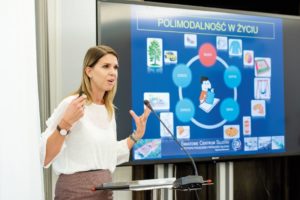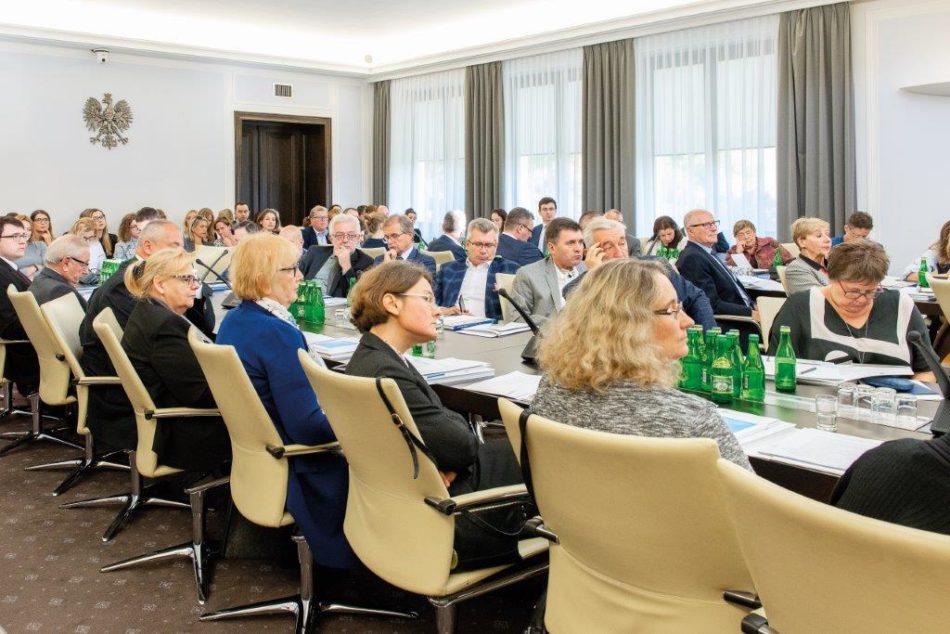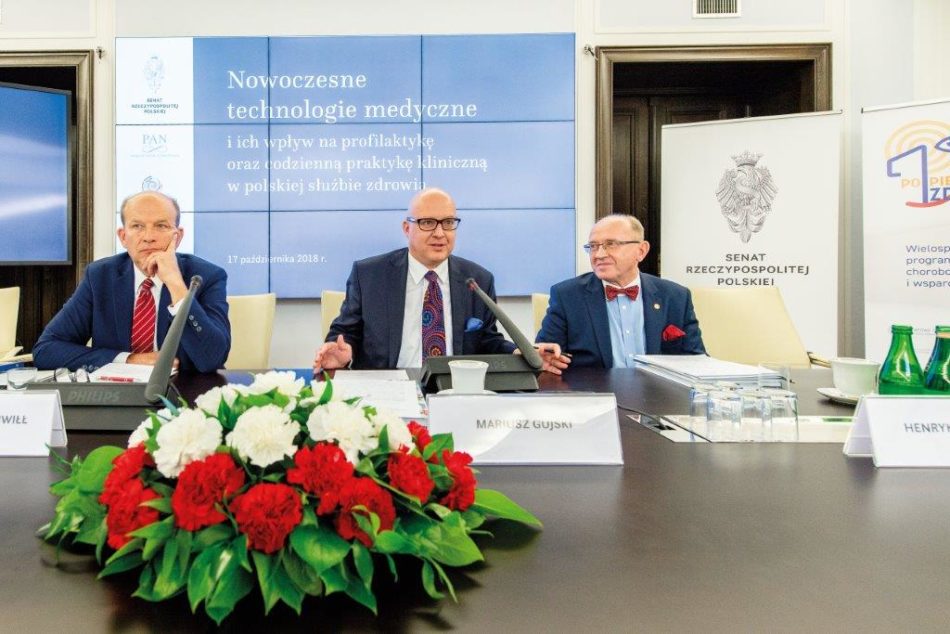The debate titled “Modern medical technologies and their impact on prophylaxis and everyday clinical practice in the Polish healthcare system” co-organized by professor Henryk Skarzynski and the Speaker of the House, Mr. Stanislaw Karczewski, took place on 17 October 2018. Young physicians and scientists going through education and training in renowned scientific and clinical centers presented novel therapies. Many of them are at the very beginning of their career paths. Event coordinators decided to let their voices be heard, since the future of Polish medicine will depend on their involvement and effort.
The goal of this debate was to present scientific and clinical potential of young scientists, whose projects have potential to increase effectiveness of a therapy in a variety of diseases. – When we came up with the idea of organizing a series of debates involving physicians and scientists at the beginning of their careers, many were skeptical that the young could present such important and difficult issues – said Professor Henryk Skarzynski. – This and the previous debate showed that they can speak about the advances in treatment with enormous enthusiasm. These talks illustrate the great progress taking place in numerous fields of medicine. Many congenital diseases and syndromes, which were difficult or even impossible to treat in the past, are now treatable with the use of modern techniques and medical technologies. Fetoscopic correction of spina bifida performed in the fetus is one of such innovative solutions discussed during the debate by dr. Robert Brawura-Biskupski-Samaha of the Medical University of Warsaw. It is a minimally-invasive procedure similar to laparoscopy. It is an alternative to the traditional surgery that involves opening of the uterus as in cesarean section. Surgical technique is difficult, but yields excellent results. The procedure was performed for the first time in September 2017 by the surgical team of the 1st Chair and Department of Gynecology and Obstetrics of the Medical University of Warsaw under the leadership of Professor Miroslaw Wielgos. Eight such procedures have been performed to date.
During the debate, the revolutionary concept of epilepsy treatment in children before the spells even occur (to date it was thought that treatment could be implemented after the spells occur) was also discussed. However, in order for preventive treatment to be implemented, the diagnosis must be very early. It is not an easy task, as pediatric epilepsy might present with barely noticeable symptoms, e.g. the child stops and closes its eyes. Dr. Monika Sowinska of the Department of Pediatric Neurology of the Medical University of Warsaw spoke about methods of early detection of epileptic spells, especially among children suffering from a rare genetic disorder, so-called tuberous sclerosis (in 70-90% of children with this disease epilepsy develops as early as in the 4th to 6th month of age).
A report by dr. Dariusz Dobrowolski (Chair and Clinical Department of Ophthalmology of the Faculty of Medicine with Dentistry Division of the Medical University of Silesia in Katowice) regarding the first application of a stem cell therapy in ophthalmology also raised great interest among participants. This modality utilizes corneal epithelial stem cells; cells are isolated and proliferated, forming a tissue structure that enables reconstruction of injured (e.g. due to burning) corneal epithelium. In a not-so-distant future this agent may be also utilized in the treatment of other diseases involving ocular surface. – Use of patient’s own tissues eliminates the need to utilize donor material, does not require immunosuppression and limits inflammation associated with surgical treatment – said dr. Dariusz Dobrowolski.
Speakers also talked about utilization of many other innovative solutions, i.a. remote monitoring of patients with memory disorders (dr. Katarzyna Grabowska-Aleksandrowicz of the Medical University of Lublin), a novel targeted therapy in sleeplessness of the elderly (Michał Dermanowski MSc of the Institute of Psychiatry and Neurology), modern diagnostic methods and immunoprophylaxis of maternal-fetal conflict disease (Sylwia Purchla-Szczepiola of the Institute of Hematology and Transfusion Medicine), innovative prenatal diagnostics of congenital heart disease (Katarzyna Sobecka MSc of the Mother and Child Institute).
According to the tradition, young doctors and scientists were accompanied by journalists. As concluded by the senator Konstanty Radziwill at the end of the debate, their presence gives hope that the information on discussed methods of prophylaxis and treatment will be disseminated. The debate was moderated by Professor Henryk Skarzynski and doctor Mariusz Gujski, the deputy editor of a journal “Służba Zdrowia”.
Therapy of auditory processing disorders
 In a debate devoted to innovative medical technologies the Institute of Physiology and Pathology of Hearing was represented by Natialia Czajka MSc. In her lecture she discussed the benefits of a novel treatment modality for auditory processing disorders – the so-called Skarzynski Polymodal Sensory Perception Stimulation (SPPS-S). Below, we present a summary of her speech.
In a debate devoted to innovative medical technologies the Institute of Physiology and Pathology of Hearing was represented by Natialia Czajka MSc. In her lecture she discussed the benefits of a novel treatment modality for auditory processing disorders – the so-called Skarzynski Polymodal Sensory Perception Stimulation (SPPS-S). Below, we present a summary of her speech.
According to the definition of the American Speech-Language-Hearing Association (ASHA) central auditory processing disorders (CAPD) refer to the difficulties in processing auditory information at the central nervous system level in the presence of normal anatomy and function of peripheral organs. These processes constitute the basis of such abilities as: localization and lateralization of sounds, differentiation of sounds, sound pattern recognition, analysis of temporal aspects of the sound signal and integration of sounds in time.
Central auditory processing disorders may significantly impact everyday functioning of affected individuals. The most common difficulties include:
- difficulty hearing in noisy environment;
- difficulty following verbal instructions;
- difficulty following complex instructions;
- twisting similar-sounding words;
- frequent requests for repetitions;
- easy distraction;
- difficulty reading and writing;
- difficulty focusing attention;
- hypersensitivity to loud sounds.
Such problems may occur in isolation or coexist (with various severity and form) with other disorders. It is estimated that 2-3% of children suffer from central auditory processing disorders; however, difficulties with auditory processing in combination with other disorders may be present in several dozen percent, e.g. they affect 30% of children with dyslexia and as much as 50% of children with specific language disorders (SLI).
According to the available literature, there are three proposed approaches toward the therapy of patients with auditory processing difficulties:
- transforming the school environment,
- teaching the child strategies for compensating difficulties,
- use of auditory training focused on a specific deficit.
Skarzynski Polymodal Sensory Perception Stimulation (SPPS-S) is an example of such a training. This form of a therapy can be used in various groups of syndromes coexisting with auditory processing disorders. SPPS-S programs were developed for 6 groups of patients exhibiting problems with auditory processing coexisting with the following symptoms:
- delayed speech development
- dyslalia (speech disorder involving improper pronunciation of phonemes, that is, the smallest components of words, caused by defects or damage to peripheral articulatory organs, such as lips, teeth, tongue or palate);
- difficulty concentrating;
- difficulty reading and writing;
- stuttering;
- voice disorders.
Various senses (hearing, vision, touch) are engaged during the therapy using the SPPS-S method. Exercises are aimed at improving their integration and coordination. An innovative element of this method involves combining auditory stimulation with psychological training. An individual can hear well, but improperly interpret the incoming information on an emotional level. Such improper interpretation is not only a source of misunderstandings and cause of problems with social interactions, but may also be the cause of growing frustration resulting from a belief that “I cannot understand others, therefore others cannot understand me.” Difficult behaviors ensue as a consequence, e.g. bursts of aggression, growing fear, sometimes even psychological disorders. Therefore, the combination of auditory training with elements of psychological treatment in the SPPS-S therapy is of paramount importance and the effects exceed those offered by other treatments.
The SPPS-S therapy may be conducted both in a treatment facility as well as at home. The decision regarding the type of a therapy is made by therapists together with child’s parents. The home therapy is more comfortable (patients take the equipment home and do not have to come to the center every day for training). Deciding on a specific course of the therapy, one should take into consideration patient’s capabilities and difficulties they encounter – the group therapy may be an additional advantage for one child, but a drawback for another one. Thanks to the fact that activities are performed in an attractive manner, children do not have a sense of performing an unpleasant duty, but participate in the therapy with pleasure.







